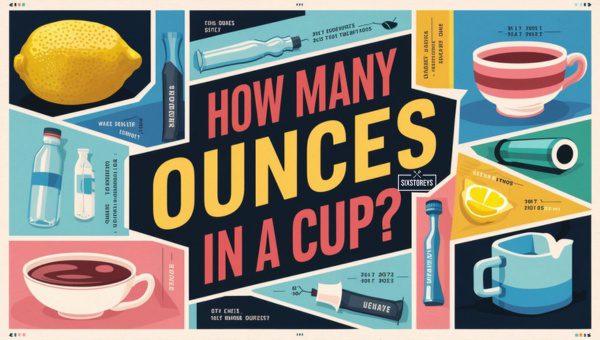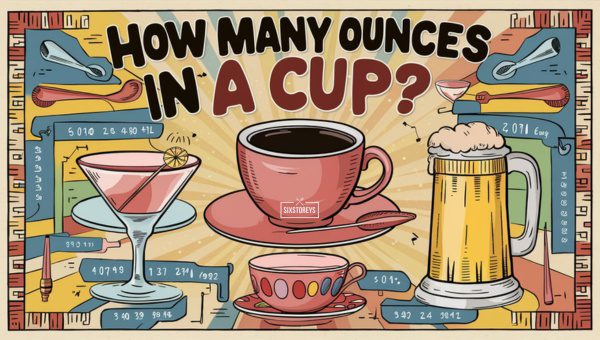How Many Ounces are in a Cup? Get the Exact Answer
Measuring ingredients accurately can make a world of difference in your cooking and baking outcomes. Whether you're whipping up a batch of homemade cookies or crafting a savory stew, precision is key. One common question that often arises is, "how many ounces in a cup?" This seemingly simple query can lead to a lot of confusion, especially for those new to the kitchen or accustomed to different measurement systems. Understanding this basic conversion is crucial for following recipes correctly and achieving the desired results. In this guide, I'll unravel the intricacies of liquid and dry measurements, explain essential conversions, and share tips to help you measure like a pro, ensuring your culinary creations turn out perfectly every time.

Also Read: How Many Ounces Is A Large Drink At McDonald's?
Article Includes
Why Knowing How Many Ounces in a Cup Matters?
Have you ever followed a recipe to the letter, only to find the final dish wasn't quite what you'd expected? The culprit could very well be inaccurate measurements. Understanding "how many ounces in a cup" is foundational for anyone who spends time in the kitchen. This knowledge ensures that you are precise with your ingredients, which can significantly affect the texture, flavor, and overall success of your dishes. Imagine making bread without knowing how much flour to accurately measure – you could end up with a dough that's too dry or too sticky. Moreover, accurate measurements are essential when scaling recipes up or down. Consistency is key in cooking and baking, and small errors can make a big difference. So, whether you're a beginner or a seasoned chef, mastering this basic measurement can elevate your culinary skills and save you from unnecessary kitchen mishaps.
The Basic Answer: How Many Ounces Are in a Cup?
So, let's get to the heart of the matter: How many ounces are in a cup? The straightforward answer for liquid measurements is that 1 cup equals 8 fluid ounces. This is a standard conversion that is used in most recipes you come across in the United States. However, it's important to note that this conversion specifically applies to liquids. When it comes to dry ingredients, the story changes a bit.
Liquid Measurements
When we talk about liquids, such as water, milk, or oil, 1 cup always equals 8 ounces. This is universally accepted and easy to remember. It's why liquid measuring cups are designed to measure in fluid ounces. For those new to the kitchen, this can make following recipes a lot simpler.
Dry Ingredients
Dry ingredients are a bit trickier. For example, 1 cup of flour does not weigh the same as 1 cup of sugar. This is because dry ingredients vary in weight and density. Therefore, while 1 cup of a liquid is always 8 fluid ounces, 1 cup of a dry ingredient might weigh more or less than 8 ounces by weight.
Quick Conversion Table
To make things easier, here’s a quick reference table:
| Type of Ingredient | 1 Cup Equals |
|---|---|
| Water, Milk, Oil | 8 fluid ounces |
| All-Purpose Flour | Approximately 4.5 ounces |
| Granulated Sugar | Approximately 7 ounces |
| Butter | 8 ounces (by weight) |
This table highlights why it's so essential to understand the type of ingredients you're working with and use the appropriate measuring tools for each. It’s these small details that often make a big difference in the kitchen.
Dry Ingredients vs. Liquid Ingredients
When it comes to measuring, not all ingredients are created equal. Understanding the difference between dry and liquid measurements is essential to getting your recipes right.
Dry Ingredients
Dry ingredients like flour, sugar, and spices can be a bit tricky to measure. One cup of flour, for example, doesn’t weigh the same as one cup of sugar. That’s because different dry ingredients have different densities. For dry ingredients, it’s often best to use a set of dry measuring cups. These cups are designed to be filled to the brim and then leveled off with a straight edge to ensure an even measurement.
Liquid Ingredients
Liquid ingredients like water, milk, and oil use a different type of cup – a liquid measuring cup. These cups usually have a spout for easy pouring and are marked with measurements on the side. Liquid measurements are all about volume, so 1 cup of water is the same as 1 cup of milk.
A crucial difference is that 1 cup of liquid is equal to 8 fluid ounces, but 1 cup of dry ingredients will vary in weight. Let’s dive into some common conversions for different ingredients to make your life in the kitchen easier.
Common Conversions: Cups to Ounces for Various Ingredients

Converting cups to ounces can be confusing because the weight of a cup of dry ingredients varies based on the ingredient. Here’s a handy list of common conversions to help you out:
| Ingredient | Volume (1 cup) | Weight (ounces) |
|---|---|---|
| All-purpose flour | 1 cup | 4.5 ounces |
| Granulated sugar | 1 cup | 7 ounces |
| Brown sugar | 1 cup | 7.5 ounces |
| Butter | 1 cup | 8 ounces (2 sticks) |
| Rolled oats | 1 cup | 3 ounces |
| Almonds (whole) | 1 cup | 5 ounces |
Understanding these conversions can save you a lot of guesswork and ensure your recipes turn out as intended. I recommend printing this table and keeping it handy in your kitchen.
Tips for Accurate Measuring
Accurate measurements are the backbone of successful cooking and baking. Here are some tips to ensure you're measuring like a pro:
Use the Right Tools
- Dry Measuring Cups: Use these for ingredients like flour, sugar, and spices. Fill the cup to the top and then level it off with a straight edge.
- Liquid Measuring Cups: These are great for water, milk, oil, and other liquids. Place the cup on a flat surface and pour the liquid in, checking the measurement at eye level.
- Digital Scale: For ultimate accuracy, especially with baking, consider using a digital kitchen scale. It allows you to measure ingredients by weight rather than volume.
Level Off Dry Ingredients
When measuring dry ingredients, don’t pack them down. Instead, use a spoon to fill the measuring cup, then level it off with a straight edge, like the back of a knife. This ensures you’re not using more than the recipe calls for.
Measure Liquids at Eye Level
For liquids, place the measuring cup on a flat surface and bend down to check the measurement at eye level. This avoids any parallax errors that can occur if you’re looking from an angle.
Use Metric Measuring for Precision
Whenever precision is crucial, consider using metric measurements. For example, 1 cup of flour roughly equals 120 grams. Recipes with metric measurements tend to be more accurate because they rely on weight rather than volume.
Keep it Consistent
Always use the same measuring tools for a recipe. Mixing and matching can lead to inconsistencies. If you start with a particular set of measuring cups or a specific scale, stick with it throughout your cooking or baking process.
Converting Recipes: When and How to Adjust Measurements
Have you ever found the perfect recipe but needed to adjust it for a different serving size? Converting recipes isn't just about multiplying or dividing the ingredient amounts. It's about doing it correctly to maintain the balance and integrity of the dish.
Scaling Up or Down
When you're doubling a recipe, you might think you can just double all the ingredients, and you're good to go. While that's mostly true, some ingredients like spices or leavening agents (baking powder, baking soda) don't always scale linearly. For these, it might be better to increase by one and a half times instead of doubling, so the flavors remain balanced.
Converting Between Systems
Sometimes, you have a recipe that uses the metric system. In such cases, understanding basic conversions is crucial. For instance, knowing that 1 cup is approximately 240 milliliters can save your dish from a disastrous outcome.
Practical Example
Let’s say a recipe calls for 2 cups of flour and serves 4, but you want it to serve just 2. You'd halve the amount of flour, resulting in 1 cup. Keep the proportions in mind to ensure that each ingredient is scaled correctly to achieve the same taste and texture.
Kitchen Tools That Make Measuring Easy
Having the right tools in your kitchen can turn the tedious task of measuring into a breeze. Here are some essentials that will make your culinary life easier.
Liquid Measuring Cups
These are specifically designed for measuring liquids like water, milk, and oil. They come in handy because they have a spout for easy pouring and usually have measurements marked in both cups and milliliters.
Dry Measuring Cups and Spoons
Dry measuring cups are usually made of plastic or metal and come in sets ranging from 1/4 cup to 1 cup. Measuring spoons, which cover smaller increments, are perfect for spices and smaller amounts of liquids.
Digital Kitchen Scale
Arguably one of the most versatile tools, a digital kitchen scale measures both dry and liquid ingredients with pinpoint accuracy. This is especially helpful for baking, where precision is key.
Conversion Table
Keep a handy conversion table nearby for quick reference. This can save you from guessing and ensure you’re using the correct amounts.
| Quantity | US Measurement | Metric Equivalent |
|---|---|---|
| 1 cup | 8 ounces | ~240 milliliters |
| 1 tablespoon | 0.5 ounces | ~15 milliliters |
| 1 teaspoon | 0.166 ounces | ~5 milliliters |
International Measurements: Cups vs. Metric System
Navigating through international recipes can be a bit tricky if you're not familiar with the measurement systems used in different countries. Here’s a breakdown to help you easily convert measurements.
US vs. Metric System
In the United States, we generally use cups, tablespoons, and teaspoons. In contrast, the metric system, used in many other parts of the world, relies on liters, milliliters, grams, and kilograms.
Basic Conversions
Knowing some basic conversions can be incredibly useful. For instance:
- 1 US cup = approximately 240 milliliters
- 1 tablespoon = around 15 milliliters
- 1 ounce = about 28 grams
Keeping It Simple
Using a digital kitchen scale that can convert between ounces and grams or cups and milliliters can make things much easier when following international recipes. Many modern scales come with a switchable unit function.
Common Ingredients
Different ingredients may require different conversion calculations. For example:
- Flour: 1 cup = 120 grams
- Sugar: 1 cup = 200 grams
- Butter: 1 cup = 227 grams
Conclusion
Mastering the art of measuring ingredients accurately is a game-changer in the kitchen. Knowing how many ounces are in a cup is a fundamental skill that can make the difference between a culinary success and a kitchen disaster. From understanding the nuances between liquid and dry measurements to utilizing the right tools, these insights can elevate your cooking and baking. Next time you grab your measuring cups or spoons, you'll do so with confidence, knowing your recipes will turn out just as intended. Happy cooking, and may your dishes always be delicious!
